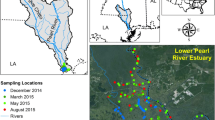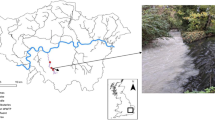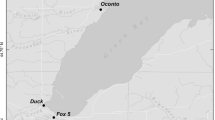Abstract
Freshwater inflows play an important role in delivering dissolved organic carbon (DOC) to estuaries. Although considerable DOC can be delivered to estuaries during episodic inflow events, such as floods, little information exists on how the bioavailability of DOC may change during these periods. In this study we used in vitro bioassay incubation experiments to examine how bioavailability changed following inflow events in two temperate south east Australian estuaries; the agricultural Bega River and the forested Clyde River. We measured short-term (2 days) and long-term (28 days) bioavailable DOC (BDOC) and determined percentage bioavailability, bacterial doubling times (BTd), all with and without excess nitrogen and phosphorus to control for nutrient limitation. Our results showed BDOC varied between 0.13 and 3.62 mg C L−1, equivalent to 2.5–31 % of initial concentrations. BTd were significantly shorter at the peak of flow and reduced as discharge returned to base flow conditions. Multiple-regression analysis showed discharge and specific ultraviolet light absorbance were the best factors for explaining variance in BDOC whilst discharge was the best factor for explaining BTd. The addition of nutrients led to significantly higher measurements of BDOC and bacteria doubling times on the Clyde River when initial phosphorus concentrations were low. These results highlight the importance of freshwater inflow events as intense moments of biogeochemical transformation in estuaries.





Similar content being viewed by others
References
Aitkenhead-Peterson J, McDowell W, Neff J (2003) Sources, production, and regulation of allochthonous dissolved organic matter inputs to surface waters. In: Aquatic ecosystems: interactivity of dissolved organic matter. Elsevier, New York, p 25–70
Anderson MJ (2001) A new method for non-parametric multivariate analysis of variance. Austral Ecol 26(1):32–46
Anderson M, Gorley R, Clarke K (2008) PERMANOVA+ for PRIMER: guide to software and statistical methods. Primer-e, Plymouth
APHA (2005) Standard methods for the examination of water and wastewater. American Public Health Association, Washington, DC
Asmala E, Autio R, Kaartokallio H, Pitkänen L, Stedmon C, Thomas D (2013) Bioavailability of riverine dissolved organic matter in three Baltic Sea estuaries and the effect of catchment land use. Biogeosciences 10(11):9819–9865
Azam F, Fenchel T, Field J, Gray J, Meyer-Reil L, Thingstad F (1983) The ecological role of water-column microbes in the sea. Mar Ecol Prog Ser 10(3):257–263
Battin T, Kaplan L, Findlay S, Hopkinson C, Marti E, Packman A, Newbold J, Sabater F (2008) Biophysical controls on organic carbon fluxes in fluvial networks. Nat Geosci 1(2):95–100
Berggren M, Laudon H, Jansson M (2009) Aging of allochthonous organic carbon regulates bacterial production in unproductive boreal lakes. Limnol Oceanogr 54(4):1333–1342
Berggren M, Laudon H, Haei M, Strom L, Jansson M (2010) Efficient aquatic bacterial metabolism of dissolved low-molecular-weight compounds from terrestrial sources. ISME J 4(3):408–416
Brierley GJ, Cohen T, Fryirs K, Brooks A (1999) Post-European changes to the fluvial geomorphology of Bega catchment, Australia: implications for river ecology. Freshw Biol 41(4):839–848
Brooks AP, Brierley GJ (1997) Geomorphic responses of lower Bega River to catchment disturbance, 1851–1926. Geomorphology 18(3–4):291–304
Buffam I, Galloway J, Blum L, McGlathery K (2001) A stormflow/baseflow comparison of dissolved organic matter concentrations and bioavailability in an Appalachian stream. Biogeochemistry 53(3):269–306
Catalán N, Obrador B, Felip M, Pretus JL (2013) Higher reactivity of allochthonous vs. autochthonous DOC sources in a shallow lake. Aquat Sci 75(4):581–593
Chapelle FH, Bradley PM, Goode DJ, Tiedeman C, Lacombe PJ, Kaiser K, Benner R (2009) Biochemical indicators for the bioavailability of organic carbon in ground water. Ground Water 47(1):108–121
Cole JJ, Carpenter SR, Kitchell J, Pace ML, Solomon CT, Weidel B (2011) Strong evidence for terrestrial support of zooplankton in small lakes based on stable isotopes of carbon, nitrogen, and hydrogen. Proc Natl Acad Sci USA 108(5):1975
Cunha MA, Dias JM, Almeida MA, Lopes JF, Alcantara E (2003) Fluxes of bacterioplankton between a tidal estuary and the sea: returning to the “Outwelling Hypothesis”. Aquat Ecol 37(1):45–54
del Giorgio P, Davis J (2003) Patterns in dissolved organic matter lability and consumption across aquatic ecosystems. In: Aquatic ecosystems: interactivity of dissolved organic matter. Academic Press, San Diego, p 399–424
Elser J, Stabler L, Hassett R (1995) Nutrient limitation of bacterial growth and rates of bacterivory in lakes and oceans: a comparative study. Aquat Microb Ecol 9(2):105–110
Faithfull C, Huss M, Vrede T, Karlsson J, Bergstrom AK (2012) Transfer of bacterial production based on labile carbon to higher trophic levels in an oligotrophic pelagic system. Can J Fish Aquat Sci 69(1):85–93
Farjalla VF, Azevedo DA, Esteves FA, Bozelli RL, Roland F, Enrich-Prast A (2006) Influence of hydrological pulse on bacterial growth and DOC uptake in a clear-water Amazonian lake. Microb Ecol 52(2):334–344
Fellman JB, D’Amore DV, Hood E, Boone RD (2008) Fluorescence characteristics and biodegradability of dissolved organic matter in forest and wetland soils from coastal temperate watersheds in southeast Alaska. Biogeochemistry 88(2):169–184
Fellman JB, Hood E, Edwards RT, D’Amore DV (2009) Changes in the concentration, biodegradability, and fluorescent properties of dissolved organic matter during stormflows in coastal temperate watersheds. J Geophys Res Biogeosci 114:1–14
Green RE, Bianchi TS, Dagg MJ, Walker ND, Breed GA (2006) An organic carbon budget for the Mississippi River turbidity plume and plume contributions to air-sea CO2 fluxes and bottom water hypoxia. Estuaries Coasts 29(4):579–597
Gremm TJ, Kaplan L (1998) Dissolved carbohydrate concentration, composition, and bioavailability to microbial heterotrophs in stream water. Acta Hydrochim Hydrobiol 26(3):167–171
Guillemette F, Del Giorgio PA (2011) Reconstructing the various facets of dissolved organic carbon bioavailability in freshwater ecosystems. Limnol Oceanogr 56(2):734–748
Hanisch JR, Tonn WM, Paszkowski CA, Scrimgeour GJ (2010) δ13C and δ15N signatures in muscle and fin tissues: nonlethal sampling methods for stable isotope analysis of salmonids. N Am J Fish Manag 30(1):1–11
Hinton M, Schiff S, English M (1997) The significance of storms for the concentration and export of dissolved organic carbon from two Precambrian Shield catchments. Biogeochemistry 36(1):67–88
Hitchcock JN, Mitrovic SM (2013) Different resource limitation by carbon, nitrogen and phosphorus between base flow and high flow conditions for estuarine bacteria and phytoplankton. Estuar Coast Shelf Sci 135:106–115
Hitchcock JN, Mitrovic SM (2014) Highs and lows: the effect of differently sized freshwater inflows on estuarine carbon, nitrogen, phosphorus, bacteria and chlorophyll a dynamics. Estuar, Coast Shelf Sci. doi: 10.1016/j.ecss.2014.12.002
Hitchcock JN, Mitrovic SM, Kobayashi T, Westhorpe DP (2010) Responses of estuarine bacterioplankton, phytoplankton and zooplankton to dissolved organic carbon (DOC) and inorganic nutrient additions. Estuaries Coasts 33(1):78–91
Hood E, Gooseff MN, Johnson SL (2006) Changes in the character of stream water dissolved organic carbon during flushing in three small watersheds, Oregon. J Geophys Res Biogeosci 111(G1):1–8
Howarth R, Schneider R, Swaney D (1996) Metabolism and organic carbon fluxes in the tidal freshwater Hudson River. Estuaries Coasts 19(4):848–865
Inamdar S, Singh S, Dutta S, Levia D, Mitchell M, Scott D, Bais H, McHale P (2011) Fluorescence characteristics and sources of dissolved organic matter for stream water during storm events in a forested mid-Atlantic watershed. J Geophys Res Biogeosci 116(G3):1–23
Judd K, Crump B, Kling G (2006) Variation in dissolved organic matter controls bacterial production and community composition. Ecology 87(8):2068–2079
Leff LG, Meyer JL (1991) Biological availability of dissolved organic carbon along the Ogeechee River. Limnol Oceanogr 36:315–323
Marín-Spiotta E, Gruley K, Crawford J, Atkinson E, Miesel J, Greene S, Cardona-Correa C, Spencer R (2014) Paradigm shifts in soil organic matter research affect interpretations of aquatic carbon cycling: transcending disciplinary and ecosystem boundaries. Biogeochemistry 117(2–3):279–297
McLaughlin C, Kaplan LA (2013) Biological lability of dissolved organic carbon in stream water and contributing terrestrial sources. Freshw Sci 32(4):1219–1230
Mitrovic SM, Westhorpe DP, Kobayashi T, Baldwin DS, Ryan D, Hitchcock JN (2014) Short term changes in zooplankton density and community structure in response to different sources of dissolved organic carbon in an unconstrained lowland river: evidence for food web support. J Plankton Res 36(6):1488–1500
Nguyen HV-M, Hur J, Shin H-S (2010) Changes in spectroscopic and molecular weight characteristics of dissolved organic matter in a river during a storm event. Water Air Soil Pollut 212(1–4):395–406
Peter S, Shen Y, Kaiser K, Benner R, Durisch-Kaiser E (2012) Bioavailability and diagenetic state of dissolved organic matter in riparian groundwater. J Geophys Res Biogeosci 117(G4):1–10
Pomeroy L (1974) The ocean’s food web, a changing paradigm. Bioscience 24:499–504
Porter K, Feig Y (1980) The use of DAPI for identifying and counting aquatic microflora. Limnol Oceanogr 25:943–948
Raymond PA, Saiers JE (2010) Event controlled DOC export from forested watersheds. Biogeochemistry 100(1):197–209
Rosemond AD, Benstead JP, Bumpers PM, Gulis V, Kominoski JS, Manning DW, Suberkropp K, Wallace JB (2015) Experimental nutrient additions accelerate terrestrial carbon loss from stream ecosystems. Science 347(6226):1142–1145
Roy PS, Williams RJ, Jones AR, Yassini I, Gibbs PJ, Coates B, West RJ, Scanes PR, Hudson JP, Nichol S (2001) Structure and function of south-east Australian estuaries. Estuar Coast Shelf Sci 53(3):351–384
Sanderman J, Baldock JA, Amundson R (2008) Dissolved organic carbon chemistry and dynamics in contrasting forest and grassland soils. Biogeochemistry 89(2):181–198
Schmidt MW, Torn MS, Abiven S, Dittmar T, Guggenberger G, Janssens IA, Kleber M, Kögel-Knabner I, Lehmann J, Manning DA (2011) Persistence of soil organic matter as an ecosystem property. Nature 478(7367):49–56
Selinummi J, Seppala J, Yli-Harja O, Puhakka JA (2005) Software for quantification of labeled bacteria from digital microscope images by automated image analysis. Biotechniques 39(6):859
Sobczak W, Findlay S (2002) Variation in bioavailability of dissolved organic carbon among stream hyporheic flowpaths. Ecology 83(11):3194–3209
Thingstad F, Hagström A, Rassoulzadegan F (1997) Accumulation of degradable DOC in surface waters: is it caused by a malfunctioning microbial loop? Limnol Oceanogr 42(2):398–404
Tozer M, Turner K, Simpson C, Keith D, Beukers P, MacKenzie B, Tindall D, Pennay C (2010) Native vegetation of southeast NSW: a revised classification and map for the coast and eastern tablelands. Royal Botanic Gardens, National Herbarium of New South Wales, Sydney
Traina SJ, Novak J, Smeck NE (1990) An ultraviolet absorbance method of estimating the percent aromatic carbon content of humic acids. J Environ Qual 19(1):151–153
Vidon P, Wagner LE, Soyeux E (2008) Changes in the character of DOC in streams during storms in two Midwestern watersheds with contrasting land uses. Biogeochemistry 88(3):257–270
Wainright S, Hopkinson C Jr (1997) Effects of sediment resuspension on organic matter processing in coastal environments: a simulation model. J Mar Syst 11(3):353–368
Webster J, Benfield E, Golladay S, Hill B, Hornick L, Kazmierczak R, Perry W (1987) Experimental studies of physical factors affecting seston transport in streams. Limnol Oceanogr 32:848–863
Wetzel RG, Hatcher PG, Bianchi TS (1995) Natural photolysis by ultraviolet irradiance of recalcitrant dissolved organic matter to simple substrates for rapid bacterial metabolism. Limnol Oceanogr 40(8):1369–1380
Wiegner TN, Tubal RL, MacKenzie RA (2009) Bioavailability and export of dissolved organic matter from a tropical river during base-and stormflow conditions. Limnol Oceanogr 54(4):1233–1242
Wikner J, Cuadros R, Jansson M (1999) Differences in consumption of allochthonous DOC under limnic and estuarine conditions in a watershed. Aquat Microb Ecol 17(3):289–299
Wilson HF, Saiers JE, Raymond PA, Sobczak WV (2013) Hydrologic drivers and seasonality of dissolved organic carbon concentration, nitrogen content, bioavailability, and export in a forested New England stream. Ecosystems 16(4):1–13
Yoro SC, Panagiotopoulos C, Sempéré R (1999) Dissolved organic carbon contamination induced by filters and storage bottles. Water Res 33(8):1956–1959
Zweifel UL, Norrman B, Hagstrom A (1993) Consumption of dissolved organic carbon by marine bacteria and demand for inorganic nutrients. Mar Ecol Prog Ser 101:23–32
Acknowledgments
This work was supported by the Peter Cullen Postgraduate Scholarship funded by the NSW Office of Water, Sydney Catchment Authority, State Water, Hunter Water and Sydney Water. Dr John Brayan and the staff of the NSW Office of Water laboratory are thanked for their assistance in sample analysis, and Ann-Marie Rohlfs for field and laboratory assistance. Thank you to Darren Baldwin, Joel Hoffman and other anonymous reviewers for their helpful comments.
Author information
Authors and Affiliations
Corresponding author
Additional information
Responsible Editor: Colin Bell
Rights and permissions
About this article
Cite this article
Hitchcock, J.N., Mitrovic, S.M. After the flood: changing dissolved organic carbon bioavailability and bacterial growth following inflows to estuaries. Biogeochemistry 124, 219–233 (2015). https://doi.org/10.1007/s10533-015-0094-3
Received:
Accepted:
Published:
Issue Date:
DOI: https://doi.org/10.1007/s10533-015-0094-3




